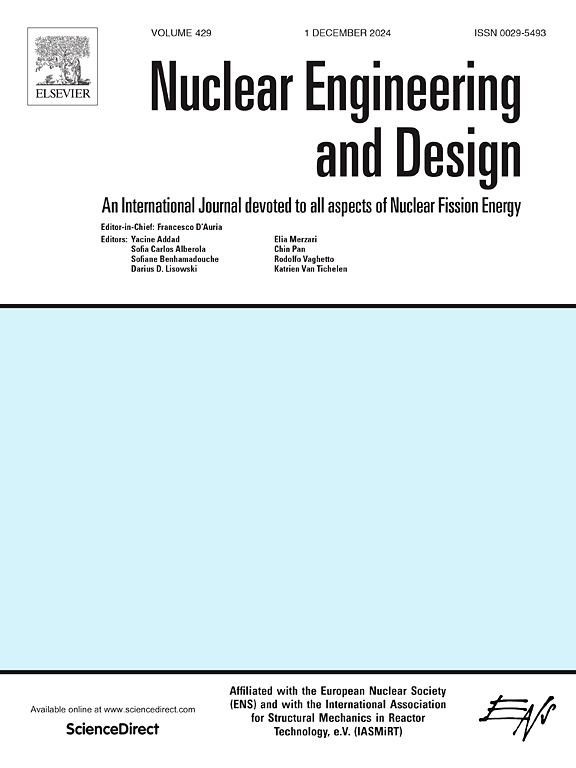The tail-oriented multi-normal model method for partially correlated seismic fragilities in probabilistic risk assessment
IF 1.9
3区 工程技术
Q1 NUCLEAR SCIENCE & TECHNOLOGY
引用次数: 0
Abstract
Many seismic-induced failures are due to shaking effects in response to common ground motions. Since the effects of shaking are propagated to equipment with varying configurations located at the same or different locations, there is often a degree of partial correlation between these failures. Common practice in seismic probabilistic risk assessment (SPRA) of nuclear facilities typically idealizes this partial correlation as either perfect correlation or full independence. Recent studies indicate that refining this practice for structures or components with considerable risk contributions can lead to significant effects on the SPRA outcome. Methods and techniques to incorporate the modelling of partial correlation in SPRA models have received increasing research attention in recent years, and a few recent SPRAs explicitly modelled it for risk-significant contributors. While applicable to single-unit (SU) SPRA, explicit modelling of seismic fragility partial correlation may be even more impactful for multi-unit (MU) SPRA.
Several methods with various degrees of rigor exist in the literature for explicitly modelling partial correlation between seismic fragilities in a probabilistic risk quantification. The available rigorous methods typically involve the use of numerical simulation or computationally intensive numerical analysis, which are not practical for inclusion in SPRA qualification. This article discusses the tail-oriented multi-normal model (TMM) method, a robust technique for explicitly modelling partial correlation between seismic fragilities in SPRA applications. The TMM method is based on the Separation of Independent and Common Variables (SICV) concept and is superior to other SICV-based techniques in that it uses an efficient closed-form formulation. This analytical solution is premised on the lognormal probability distribution being a valid representation of seismic-induced failure fragilities, which is commonly accepted in SPRA.
This article is divided into an introduction and four sections. The introduction reviews available relevant literature on the topic, presents relevant technical background elements, and summarizes specific current technical challenges. The first section introduces the TMM method formulation, and implementation steps. The second section presents validation examples. The third section discusses the determination of partial correlation factors and the sensitivity of the TMM method results to the accuracy of the partial correlation factors. The fourth section discusses the use of the TMM method in SPRA models.
The performance of the TMM method is found to be more favourable than the widely used Reed-McCann method both computationally (processing time) and analytically (solution accuracy). The TMM method results are found to be weakly sensitive to fragility analyst judgement in quantifying partial correlation, making it robust against potential bias in such judgements. Furthermore, the TMM method can be readily integrated into SPRA quantification software using two model development alternatives.
部分相关地震易损性概率风险评估的尾向多正态模型方法
许多地震引起的破坏是由于共同地面运动引起的震动效应。由于震动的影响会传播到位于相同或不同位置的不同配置的设备,因此这些故障之间通常存在一定程度的部分相关性。在核设施地震概率风险评估(SPRA)中,通常将这种部分相关性理想化为完全相关或完全独立。最近的研究表明,对于具有相当大风险贡献的结构或部件,改进这种做法可能会对SPRA结果产生重大影响。近年来,将部分相关建模纳入SPRA模型的方法和技术受到了越来越多的研究关注,最近的一些SPRA明确地为风险显著贡献者建模。虽然明确的地震易损性偏相关建模适用于单单元(SU) SPRA,但对多单元(MU) SPRA可能更有影响。文献中存在几种不同严格程度的方法,用于在概率风险量化中明确地模拟地震易损性之间的部分相关性。现有的严格方法通常包括使用数值模拟或计算密集的数值分析,这些方法对于纳入SPRA资格来说是不切实际的。本文讨论了面向尾的多正态模型(TMM)方法,这是一种在SPRA应用中明确模拟地震易发性部分相关的鲁棒技术。TMM方法基于独立变量和公共变量分离(SICV)概念,并且优于其他基于SICV的技术,因为它使用了有效的封闭形式公式。该解析解的前提是对数正态概率分布是地震诱发破坏脆弱性的有效表示,这是SPRA中普遍接受的。本文分为导论和四个部分。引言部分回顾了关于该主题的现有相关文献,介绍了相关的技术背景元素,并总结了当前具体的技术挑战。第一部分介绍了TMM方法的制定和实现步骤。第二部分给出验证示例。第三部分讨论了偏相关因子的确定以及TMM方法结果对偏相关因子准确性的敏感性。第四部分讨论了TMM方法在SPRA模型中的应用。TMM方法在计算(处理时间)和分析(求解精度)方面都优于广泛使用的Reed-McCann方法。发现TMM方法结果在量化偏相关时对脆弱性分析师判断弱敏感,使其对此类判断中的潜在偏差具有鲁棒性。此外,TMM方法可以很容易地集成到SPRA量化软件中,使用两种模型开发方案。
本文章由计算机程序翻译,如有差异,请以英文原文为准。
求助全文
约1分钟内获得全文
求助全文
来源期刊

Nuclear Engineering and Design
工程技术-核科学技术
CiteScore
3.40
自引率
11.80%
发文量
377
审稿时长
5 months
期刊介绍:
Nuclear Engineering and Design covers the wide range of disciplines involved in the engineering, design, safety and construction of nuclear fission reactors. The Editors welcome papers both on applied and innovative aspects and developments in nuclear science and technology.
Fundamentals of Reactor Design include:
• Thermal-Hydraulics and Core Physics
• Safety Analysis, Risk Assessment (PSA)
• Structural and Mechanical Engineering
• Materials Science
• Fuel Behavior and Design
• Structural Plant Design
• Engineering of Reactor Components
• Experiments
Aspects beyond fundamentals of Reactor Design covered:
• Accident Mitigation Measures
• Reactor Control Systems
• Licensing Issues
• Safeguard Engineering
• Economy of Plants
• Reprocessing / Waste Disposal
• Applications of Nuclear Energy
• Maintenance
• Decommissioning
Papers on new reactor ideas and developments (Generation IV reactors) such as inherently safe modular HTRs, High Performance LWRs/HWRs and LMFBs/GFR will be considered; Actinide Burners, Accelerator Driven Systems, Energy Amplifiers and other special designs of power and research reactors and their applications are also encouraged.
 求助内容:
求助内容: 应助结果提醒方式:
应助结果提醒方式:


